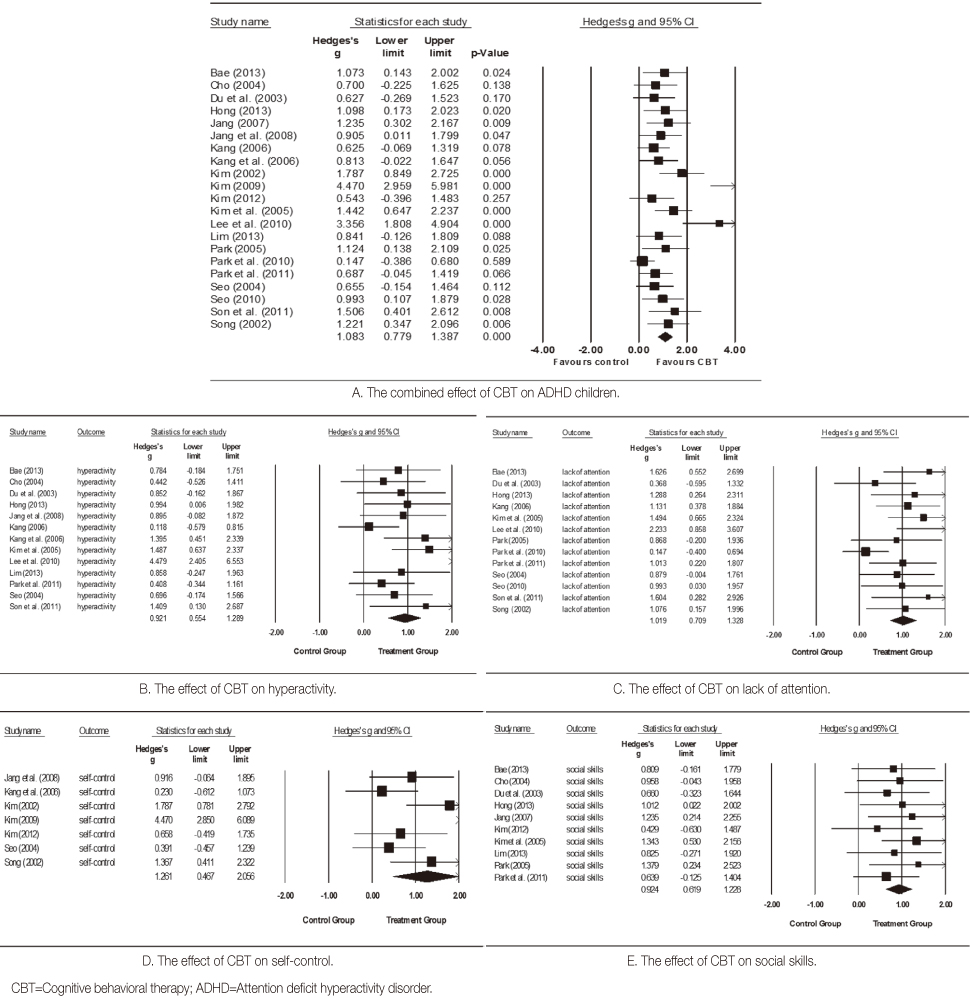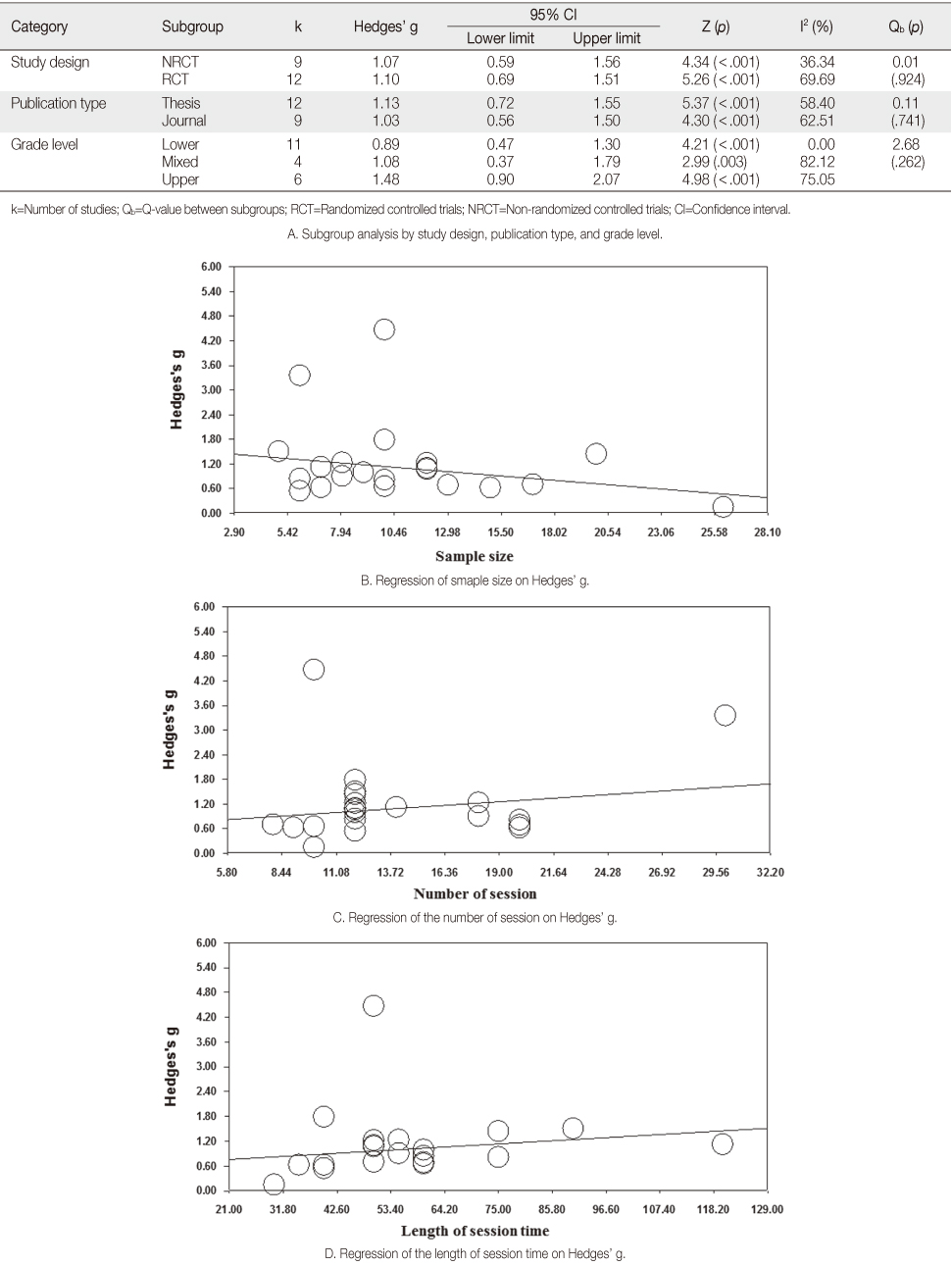J Korean Acad Nurs.
2015 Apr;45(2):169-182. 10.4040/jkan.2015.45.2.169.
Effects of Cognitive Behavioral Therapy on Attention Deficit Hyperactivity Disorder among School-aged Children in Korea: A Meta-Analysis
- Affiliations
-
- 1College of Nursing, Kyungpook National University, Daegu, Korea.
- 2Research Institute of Nursing Science, Kyungpook National University, Daegu, Korea.
- 3College of Social Sciences, Kyungpook National University, Daegu, Korea. sungdong@knu.ac.kr
- KMID: 2359855
- DOI: http://doi.org/10.4040/jkan.2015.45.2.169
Abstract
- PURPOSE
This study was a meta-analysis designed to identify effects of Cognitive Behavioral Therapy (CBT) interventions in alleviating main symptoms of Attention Deficit Hyperactivity Disorder (ADHD) among school-aged children in Korea.
METHODS
Examination of several databases including Research Information Sharing Service, Korean Studies Information Service System, Data Base Periodical Information Academic and hand-searched article references, resulted in identification of 1,298 studies done between 2000 and 2013 of which 21 met the inclusion criteria. Comprehensive Meta-Analysis version 2.0 was used to analyze effect sizes, explore possible causes of heterogeneity, and check publication bias with a funnel plot and its trim-and-fill analysis.
RESULTS
Overall effect size of CBT intervention was large (g=1.08) along with each outcome of self-control (g=1.26), lack of attention (g=1.02), social skills (g=0.92), and hyperactivity (g=0.92). For heterogeneity, moderator analysis was performed, but no significant differences were found between the RCT (Randomized Controlled Trials) group and the NRCT (Non RCT) group. Also, meta-regression was performed using sample size, number of sessions, and length of session as predictors, but no statistically significant moderators were found. Finally, a funnel plot along with trim-and-fill analysis was produced to check for publication bias, but no significant bias was detected.
CONCLUSION
Based on these findings, there is clear evidence that CBT intervention has significant positive effects on the main symptoms of school-aged children suffering ADHD. Further research is needed to target diverse age groups with ADHD along with more RCT studies to improve the effectiveness of the CBT intervention.
MeSH Terms
Figure
Cited by 2 articles
-
Effects of a Social Skills Training Program on Problem Behaviors, Social Skill, and Peer Relationship in Children using a Community Child Center at Vulnerable Area
Myeong-Hui Choe, Yong-Mi Lee
J Korean Acad Psychiatr Ment Health Nurs. 2015;24(3):156-167. doi: 10.12934/jkpmhn.2015.24.3.156.A Meta Analysis on Variables related to Death Anxiety of Elderly in Korea
Sinhyang Kim, Kyung Sook Park
Korean J Adult Nurs. 2016;28(2):156-168. doi: 10.7469/kjan.2016.28.2.156.
Reference
-
1. Park HJ, Heo JY, Kim YH, Song HJ. Development and effects of a combined program of cognitive enhancement - social skills - parents training program for ADHD children and their parents. J Emot Behav Disord. 2011; 27(3):25–58.2. Biederman J, Kwon A, Aleardi M, Chouinard VA, Marino T, Cole H, et al. Absence of gender effects on attention deficit hyperactivity disorder: Findings in nonreferred subjects. Am J Psychiatry. 2005; 162(6):1083–1089. DOI: 10.1176/appi.ajp.162.6.1083.3. Health Insurance Review & Assessment Service. Children and adolescent attention deficit hyperactivity disorder: Eight out of ten people [Internet]. Seoul: Author;2012. cited 2012 May 10. Available from: http://www.hira.or.kr/co/searchCms.do?catid=14hi6_2&collection=cms&startCount=0&pgmid=HIRAA020041000000&field=subject&search_word=%EC%86%8C%EC%95%84%C2%B7%EC%B2%AD%EC%86%8C%EB%85%84+%EC%A3%BC%EC%9D%98%EB%A0%A5%EA%B2%B0%ED%95%8D%EC%9E%A5%EC%95%A0.4. Kim IH. Effect of the group art therapy in children with attention-deficit hyperactivity disorder (ADHD). J Korean Acad Psychiatr Ment Health Nurs. 2006; 15(2):152–160.5. Oh WO, Park ES. Parenting experiences of parents of children with ADHD: Approaching the normal. J Korean Acad Nurs. 2007; 37(1):91–104.6. Kim IH. The effect of social skills training with attention-deficit hyperactivity disorder (ADHD). J Korean Acad Psychiatr Ment Health Nurs. 2007; 16(4):420–428.7. Lee DH, Kim MS, Song YJ, Kwon BM. An exploratory review of literature on peer relationship of children with ADHD. Korean J Couns Psychother. 2013; 25(3):643–672.8. Park SH, Go H. A case study applying both cognitive behavioral therapy and art psychotherapy to an ADHD child. J Arts Psychother. 2010; 6(2):79–99.9. Seo JY, Park WJ. The meta analysis of trends and the effects of nonpharmacological intervention for school aged ADHD children. J Korean Acad Psychiatr Ment Health Nurs. 2010; 19(2):117–132.10. Kim Y, Seo S. Current trends and issues in non-medication interventions to address the academic impairment of children and adolescents with ADHD. Korean J Sch Psychol. 2011; 8(1):79–110.11. Song CJ, Koo BH, Bai DS. Item selection and analysis for the development of Korean attention deficit hyperactivity disorder rating scale. J Emot Behav Disord. 2006; 22(1):1–26.12. Higgins JPT, Green S, editors. Cochrane handbook for systematic reviews of interventions version 5.1.0 [Internet]. London, UK: The Cochrane Collaboration;2011. cited 2011 March 20. Available from: http://handbook.cochrane.org/.13. Cully JA, Teten AL. A therapist's guide to brief cognitive behavioral therapy. Houston, TX: South Central Mental Illness Research, Education, and Clinical Center;2008.14. Scottish Intercollegiate Guidelines Network. SIGN 50: A guideline developer's handbook [Internet]. Edinburgh, UK: Author;2011. cited 2012 May 29. Available from: http://www.sign.ac.uk/guidelines/fulltext/50/index.html.15. Borenstein M, Hedges LV, Higgins JPT, Rothstein HR. Introduction to meta-analysis. West Sussex, UK: John Wiley & Sons, Ltd.;2009.16. Cohen J. Statistical power analysis for the behavioral sciences. 2nd ed. Hillsdale, NJ: Lawrence Erlbaum Associates;1988.17. Rosenthal R, Rubin DB. A simple, general purpose display of magnitude of experimental effect. J Educ Psychol. 1982; 74(2):166–169.18. Littell JH, Corcoran J, Pillai V. Systematic reviews and meta-analysis. New York, NY: Oxford University Press;2008.19. Egger M, Smith GD, Schneider M, Minder C. Bias in meta-analysis detected by a simple, graphical test. BMJ. 1997; 315(7109):629–634.20. Duval S, Tweedie R. A nonparametric "trim and fill" method of accounting for publication bias in meta-analysis. J Am Stat Assoc. 2000; 95(449):89–98. DOI: 10.1080/01621459.2000.10473905.21. Miranda A, Presentación MJ, Soriano M. Effectiveness of a school-based multicomponent program for the treatment of children with ADHD. J Learn Disabil. 2002; 35(6):546–562.22. Kang SH, Hong JM, Baek YH. The effect of group art activity program on impulsiveness and self-control of children with attention deficit hyperactivity. Korean J Art Ther. 2006; 13(1):23–48.23. Lee Y. A meta-analysis of the effect of group counseling programs on ADHD children's behavior change [master's thesis]. Cheongju: Korea National University of Education;2006.24. Van der Oord S, Prins PJ, Oosterlaan J, Emmelkamp PM. Efficacy of methylphenidate, psychosocial treatments and their combination in school-aged children with ADHD: A meta-analysis. Clin Psychol Rev. 2008; 28(5):783–800. DOI: 10.1016/j.cpr.2007.10.007.25. Ghafoori B, Tracz SM. Effectiveness of cognitive-behavioral therapy in reducing classroom disruptive behaviors: A meta-analysis. Washington, DC: Education Resources Information Center;2001. Report No.: ERIC Document Reproduction Service No. ED 457182.26. Toplak ME, Connors L, Shuster J, Knezevic B, Parks S. Review of cognitive, cognitive-behavioral, and neural-based interventions for attention-deficit/hyperactivity disorder (ADHD). Clin Psychol Rev. 2008; 28(5):801–823. DOI: 10.1016/j.cpr.2007.10.008.27. Fabiano GA, Pelham WE Jr, Coles EK, Gnagy EM, Chronis-Tuscano A, O'Connor BC. A meta-analysis of behavioral treatments for attention-deficit/hyperactivity disorder. Clin Psychol Rev. 2009; 29(2):129–140. DOI: 10.1016/j.cpr.2008.11.001.28. Kim JU, Cheon SM, Hwang HJ. A comparison of the effect of cognitive/behavioral NLP group counseling on behavior and school life adjustment of ADHD children. Korean J Couns. 2005; 6(3):777–788.29. Sohn JN. The effects of the peer suicide prevention gatekeeper program for middle school students. J Korean Acad Psychiatr Ment Health Nurs. 2011; 20(1):111–119.30. Curtis DF, Pisecco S, Hamilton RJ, Moore DW. Teacher perceptions of classroom interventions for children with ADHD: A cross-cultural comparison of teachers in the United States and New Zealand. Sch Psychol Q. 2006; 21(2):171–196.
- Full Text Links
- Actions
-
Cited
- CITED
-
- Close
- Share
- Similar articles
-
- The Effect of Attention Level of Attention Deficit Hyperactivity Disorder on CPT and WCST
- Diagnosis and Comorbidity of Attention Deficit Hyperactivity Disorder in School-Aged Children
- An Update on Mental Health Problems and Cognitive Behavioral Therapy in Pediatric Obesity
- Meta Analysis of Variables Related to Attention Deficit Hyperactivity Disorder in School-Age Children
- Non-Stimulant Medications in the Treatment of Attention-Deficit Hyperactivity Disorder





